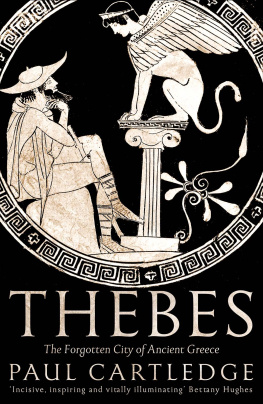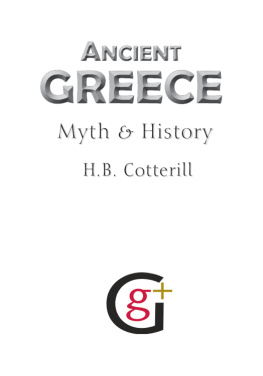KINSHIP MYTH IN ANCIENT GREECE
KINSHIP MYTH IN ANCIENT GREECE
LEE E. PATTERSON

This book has been supported by an endowment dedicated to classics and the ancient world and funded by the Aret Foundation; the Gladys Krieble Delmas Foundation; the Dougherty Foundation; the James R. Dougherty, Jr. Foundation; the Rachael and Ben Vaughan Foundation; and the National Endowment for the Humanities.
Copyright 2010 by the University of Texas Press
All rights reserved
Printed in the United States of America
First edition, 2010
Requests for permission to reproduce
material from this work should be sent to:
Permissions
University of Texas Press
P.O. Box 7819
Austin, TX 78713-7819
www.utexas.edu/utpress/about/bpermission.html
 The paper used in this book meets the minimum requirements of
The paper used in this book meets the minimum requirements of
ANSI/NISO Z39.48-1992 (R1997) (Permanence of Paper).
Library of Congress Cataloging-in-Publication Data
Patterson, Lee.
Kinship myth in ancient Greece / Lee E. Patterson. 1st ed.
p. cm.
Includes bibliographical references and index.
ISBN 978-0-292-72275-0 (cloth : alk. paper)
1. KinshipGreeceHistory. 2. Mythology, Greek. 3. Civilization, Ancient. 4. GreeceCivilization. 5. GreeceForeign relations. 6. GreecePolitics and government. I. Title.
GN585.G85P37 2010
938dc22
2010019016
For my father,
Stanley Mac Patterson,
and in loving memory of my mother,
Vanessa Leigh Patterson
ABBREVIATIONS
AJA | American Journal of Archaeology |
AJAH | American Journal of Ancient History |
AJP | American Journal of Philology |
AncW | Ancient World |
Bernab | Poetarum Epicorum Graecorum, ed. A. Bernab |
CA | Classical Antiquity |
CJ | Classical Journal |
CP | Classical Philology |
CQ | Classical Quarterly |
DK | Die Fragmente der Vorsokratiker, eds. H. Diels and W. Kranz |
Erbse | Scholia Graeca in Homeri Iliadem (scholia vetera), ed. Hartmut Erbse |
FGrH | Die Fragmente der griechischen Historiker, ed. F. Jacoby |
G&R | Greece and Rome |
GHI | Greek Historical Inscriptions, eds. Meiggs and Lewis |
GRBS | Greek, Roman, and Byzantine Studies |
IC | Inscriptiones Creticae |
IG | Inscriptiones Graecae |
I.v. Magnesia | Die Inschriften von Magnesia am Maeander, ed. O. Kern |
I.v. Pergamon | Die Inschriften von Pergamon (Altertmer von Pergamon Vol. 8), ed. M. Frnkel |
I.v. Priene | Die Inschriften von Priene, ed. C. Fredrich |
JCH | Journal of Contemporary History |
JHS | Journal of Hellenic Studies |
JNES | Journal of Near Eastern Studies |
JSemStud | Journal of Semitic Studies |
LIMC | Lexicon Iconographicum Mythologiae Classicae |
MDAI | Mitteilungen des Deutschen Archologischen Instituts, Athenische Abteilung |
MH | Museum Helveticum |
MW | Fragmenta Hesiodea, eds. R. Merkelbach and M. L. West |
Nauck | Tragicorum Graecorum Fragmenta, ed. A. Nauck |
PAPhS | Proceedings of the American Philosophical Society |
PCPhS | Proceedings of the Cambridge Philological Society |
P&P | Past & Present: A Journal of Historical Studies |
POxy | Oxyrhynchus Papyri |
RA | Revue Archologique |
Radt | Tragicorum Graecorum Fragmenta, ed. Stefan Radt |
RE | Pauly-Wissowa, Realencyclopdie der klassischen Altertumswissenshaft |
REG | Revue des tudes Grecques |
RPh | Revue de Philologie |
Rose | Aristotelis Fragmenta, ed. V. Rose. |
SEG | Supplementum Epigraphicum Graecum |
SIG3 | Sylloge Inscriptionum Graecarum, ed. Guilelmus Dittenberger |
StV | Die Staatsvertrge des Altertums, ed. C. H. Beck |
TAM | Tituli Asiae Minoris |
TAPA | Transactions of the American Philological Association |
TRHS | Transactions of the Royal Historical Society |
West | Iambi et Elegi ante Alexandrum Cantati, ed. M. L. West |
ZPE | Zeitschrift fr Papyrologie und Epigraphik |
NOTE ON TRANSLATIONS AND TRANSLITERATIONS
In general, Greek names have been rendered in their more familiar Latinized form to ease their recognition. Terms such as sungeneia are transliterated unless part of a quotation from an original source. Translations of the Greek quotations, and in one case Latin, are mine unless otherwise indicated.
PREFACE AND ACKNOWLEDGMENTS
This book is both a beginning and an end. While the end of a long labor, I also hope that it will be the beginning of a new stage in the dialogue on how societies often use myth to construct political, social, and cultural identity. Of interest here is how and why a pair of Greek states (or leagues or kings) would cite a common ancestor, usually a legendary figure, as support or justification for their diplomatic activity. Of central importance is the authority they gave to myth, whether it was an elaborate narrative or a simple acknowledgment of an ancestor. These stories of foundations were taken seriously and accorded the respect demanded of traditions that expressed a communitys identity. But even a study limited to putative consanguinity in ancient Greek diplomacy ultimately connects to larger issues involving ethnicity, constructions of memory, perceptions of foreigners, hero cult, and so on. I was less aware of these implications when embarking on this journey many years ago as I began investigating kinship myth for my Masters thesis at the University of Mississippi and later for my dissertation at the University of Missouri. This study has taken enormous strides since then by having a larger scope than that of kinship diplomacy itself and by showing, especially in the first chapter, that in fact kinship myth is a
Next page

















 The paper used in this book meets the minimum requirements of
The paper used in this book meets the minimum requirements of